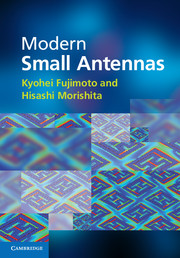Book contents
- Frontmatter
- Contents
- Preface
- Acknowledgements
- 1 Introduction
- 2 Small antennas
- 3 Properties of small antennas
- 4 Fundamental limitations of small antennas
- 5 Subjects related with small antennas
- 6 Principles and techniques for making antennas small
- 7 Design and practice of small antennas I
- 8 Design and practice of small antennas II
- 9 Evaluation of small antenna performance
- 10 Electromagnetic simulation
- 11 Glossary
- Index
- References
6 - Principles and techniques for making antennas small
Published online by Cambridge University Press: 05 January 2014
- Frontmatter
- Contents
- Preface
- Acknowledgements
- 1 Introduction
- 2 Small antennas
- 3 Properties of small antennas
- 4 Fundamental limitations of small antennas
- 5 Subjects related with small antennas
- 6 Principles and techniques for making antennas small
- 7 Design and practice of small antennas I
- 8 Design and practice of small antennas II
- 9 Evaluation of small antenna performance
- 10 Electromagnetic simulation
- 11 Glossary
- Index
- References
Summary
Principles for making antennas small
The general concept of making an antenna small is creation of an antenna having dimensions much smaller than the wavelength, keeping the performance the same as before the downsizing. From a slightly different aspect, attaining improved or enhanced antenna performance while keeping the physical dimensions of an antenna unchanged, should also be recognized as a concept similar to making an antenna small. The former is generally realization of an ESA (Electrically Small Antenna), while the latter is mostly concerned with creation of FSA (Functionally Small Antenna). When only some of the antenna dimensions are made much smaller than the wavelength, it is classified as a PCSA (Physically Constrained Small Antenna). If an antenna is simply physically small, it is a PSA (Physically Small Antenna). Typical examples of PSA are antennas used in higher frequency regions like microwave (MW) and millimeter wave (MMW) regions. These antennas have inherently small dimensions because of their operating frequencies. Antennas simply made small so that they can be placed on, for instance, a human palm, can be classified into the category of PSA. Principles and techniques to produce these small antennas differ depending on the types such as ESA, FSA, PCSA, and PSA.
Major principles for realizing an ESA are;
(1) lowering the resonance frequency for an antenna of given dimensions
(2) full use of space or volume circumscribing the maximum dimension of an antenna
(3) arranging for uniform current distributions on the antenna element, and
(4) increasing the number of radiation modes in an antenna structure.
- Type
- Chapter
- Information
- Modern Small Antennas , pp. 43 - 91Publisher: Cambridge University PressPrint publication year: 2014



